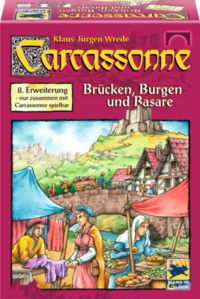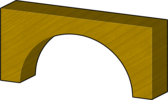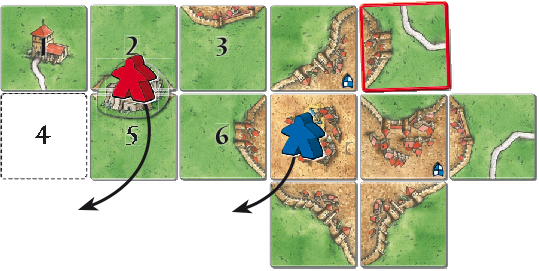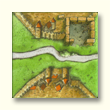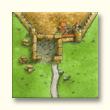Poduri, cetăți și bazaruri (prima ediție)
 |
Citești regulile pentru acest design al cartonașelor. |
 | Citește următoarele reguli dacă cartonașele tale arată astfel. |
| Dacă cartonașele tale au un design diferit, atunci alege un joc din Spin-off-uri. |  |
Hans im Glück |
Informații generale și comentarii
Extensia Poduri, cetăți și bazaruri[1][2] a fost lansată original de Hans im Glück în 2010.
Aceasta este a opta extensia majoră a jocului Carcassonne. Introduce câteva concepte noi jocului. Negustori călători ajung pe tărâm și organizează bazaruri în care târguiala este considerată o artă. În același timp, inginerii extind rețeaua de drumuri cu poduri moderne și cetăți mici sunt construite peste tot pentru a apăra regiunea.
Noile teritorii/lucruri sunt:
- Podurile
- Cetățile
- Bazarurile
O extensie Carcassonne nu este cu adevărat o extensie Carcassonne când nu are cartonașe noi, așa că în cutie vei găsi de asemenea 12 cartonașe noi care reprezintă segmente de oraș, segmente de drumuri și mănăstiri în configurație nouă plus adaosul bazarurilor care vor ajuta la crearea unui peisaj mai frumos.
Conținut
- 12 cartonașe de teren noi
- 12 jetoane cetăți
- 12 poduri de lemn
Reguli
Pregătire
Cele douăsprezece cartonașe de teren noi trebuie amestecate cu cele din jocul de bază. Pe parcursul jocului vor fi trase și plasate conform regulilor obișnuite.
Fiecare jucător primește poduri și cetăți după cum urmează, depinzând de numărul de jucători:
- Cu doi până la patru jucători, fiecare primește câte trei poduri și câte trei cetăți
- Cu cinci sau șase jucători, fiecare primește câte două poduri și câte două cetăți
Toate regulile pentru Carcassonne rămân aceleași, exceptând pentru următoarele adăugiri.
Atașarea unui cartonaș
The players draw and place tiles according to the usual rules. [3]
Bazarul
When a tile with a bazaar on it is drawn, the player should place it as usual (including placing a follower, scoring, and even not placing it if there is no place for it). [4] [5]
Then a bazaar will take place, in which land tiles will be ‘auctioned’.
The active player uncovers as many land tiles as there are players. Then the next player selects one of the tiles and declares how many points he or she would bid to keep it (it is possible to offer 0 points!). In the usual order, the rest of the players may make one bid: either they raise the current bid, or they pass.
When all players have either made a bid or passed, the player who selected the tile must make a decision, either:
- to buy the tile from the highest bidder, paying them the number of points bid, or
- to sell the tile to the highest bidder, receiving the points bid from them in return.
As such, the score of one player will be reduced on the scoreboard, and the score of another increased. If the player who selected the tile is the only one who made a bid, then the points should be subtracted from his or her score, but not awarded to anyone else. Players may bid more than they have and move their markers behind 0 on the scoring board. In this case they can place the marker on its side to show it is negative. [6] [7]
It is then the turn of the next player who has not received a tile during this bazaar. [8] Anyone who has already received a tile may no longer take part in the bidding. The last tile may be taken without payment by the remaining player who has not received a tile.
After all the tiles have been auctioned, all players place their purchased tiles as in a normal turn. [9] This begins with the player after the active player.
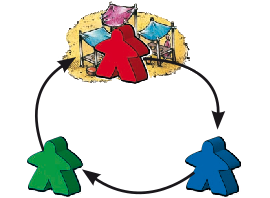
RED draws a tile with a bazaar. She places and deploys a follower to it. Then she uncovers three tiles.
* BLUE is next in the order of play, selects a tile and bids 2 points for it. GREEN passes, while RED bids 3 points. BLUE (the auctioneer) wants to keep the tile, so pays RED (the highest bidder) the 3 points; that is, BLUE reduces her score by 3 and increases that of RED by 3.
* Now GREEN selects a tile and bids 2 points for it. RED bids 3 points, and BLUE cannot bid. GREEN gives him the tile and receives 3 points.RED’s score decreases by 3.
* There is now only one tile left, which GREEN receives for free.
Beginning with BLUE, all players place their purchased tiles as in a normal turn.
Too few tiles: If a player places a bazaar and there are not enough face-down tiles for all players, no tile auction occurs. The players ignore the bazaar on the tile and the tile is played as normal. [10]
No chain reaction: If, through the placement of a bazaar tile, another bazaar tile is purchased and placed, no further tiles should be uncovered and auctioned. Only when all the uncovered tiles have been allocated and placed can another bazaar take place. [11]
Variation: As many tiles should be uncovered as there are players. Beginning with the next player, in turn each player selects one of the tiles and places it as in a normal turn. This continues until all the uncovered tiles have been allocated, and then the game continues as normal. [12] [13]
![]() Întrebare: What is the order of events if the bazaar tile extends a feature with a builder?
Întrebare: What is the order of events if the bazaar tile extends a feature with a builder?
If you draw a bazaar tile and can perform your builder-turn, first take the appropriate number of face-down tiles and perform the bazaar and the auction. Then a new round with a special property starts – each player has an open and known tile instead of drawing an unknown tile, and you cannot place your abbey as your first tile. If you placed your auctioned tile and you can perform a builder-turn, you can choose to place your abbey or draw a new unknown tile. If any player draws a new bazaar tile [for his or her builder-turn], it will be ignored until the last player who has an auctioned tile finishes his turn (including his builder-turn, if possible). Any pending delayed bazaars will take place now in turn. Once the bazaar rounds are finished, you perform your builder-turn. [14]
In other words:
- Draw bazaar and perform first part of your double turn.
- ** // Start pending bazaars // **
- Draw the tiles (still face-down)
- Turn tiles face-up and perform the auction
- ( Start delaying any new bazaars )
- 1st Player with auctioned tile (if a bazaar tile, no bazaar is triggered)
- 1st player’s builder-turn, if applicable
- Next player with auctioned tile (if a bazaar tile, no bazaar is triggered)
- Next player’s builder-turn, if applicable
- ...
- Last player with auctioned tile (if a bazaar tile, no bazaar is triggered)
- Last player’s builder-turn, if applicable
- ( Stop delaying any new bazaars )
- Player who drew and placed a new bazaar in his/her builder turn (pending delayed bazaar)
- ** Back to // Start pending bazaars // until no pending delayed bazaars **
- Perform your builder-turn (second part of your double turn)
Podurile
During his or her turn, [15] and in addition to placing a tile and deploying a follower, a player may build one bridge. [16] The bridge continues a road; that is, it carries the road over the tiles and counts exactly the same as a road segment on a land tile. [17] [18]
To build a bridge, the following conditions must be met:
- The bridge may be built on the tile which was just placed, or on an adjacent tile which touches it on one side.
- Both ends of the bridge must lie on a field (not on a city, road, river, or so on).
A player may also place the tile so that a road ends at a farm when he or she then continues the road with a bridge. A follower may be deployed to the tile; if the bridge is built on the tile being placed, the follower may be deployed to the bridge. [19] Farms or cities under a bridge are not divided. Also, several bridges may be built next to each other. [20] [21]
Cetățile
When a player creates a town – which consists of only two semi-circular city segments [22] [23] – the occupier may choose to complete and score it in the usual way (for 4 points), or to convert it into a castle. [24] [25] To convert it, the occupier places one of his or her castle tokens over the city and moves the follower occupying it into the castle. [26] [27] [28] A town which has been converted to a castle is considered to be incomplete.
No points are scored on building a castle. The player receives points only when the first structure (cloister, city, or road) in its vicinity [29] is completed during a subsequent turn. [30] [31] [32] More precisely, a segment of the structure being completed must be one or more of the tiles adjacent to the castle. The adjacent tiles are the two on which the castle lies, the two tiles to its left, and the two to its right - a total of six tiles.
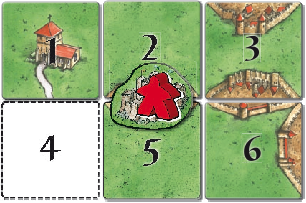
• the CLOISTER on 1
• the ROAD on 1
• the CITY at the top of 3
• the CITY on the right side of 6
(The small city on 3 and 6 was scored before the construction of the castle, and so generates no more points.)
The castle is only considered to have been completed when a structure (cloister, city, road, or another castle) which lies on at least one of the six adjacent tiles is completed. The occupier of the structure and the occupier of the castle both receive the full score [33] for the structure. Then the follower from the castle is returned to the player’s supply; the castle token remains where it is.
The following rules are also valid:
- A cloister is only considered to be adjacent when the cloister itself lies on one of the six tiles (such as tile 1 in the examples above); it is not sufficient for one of the eight tiles surrounding the cloister to be adjacent.
- The follower in the castle always receives points for the next structure to be completed. It may not be left in play in order to receive points for a structure which might be completed later.
- It does not matter whether the structure completed actually scores any points. The castle still receives points for a completed structure which is not occupied by a follower. [34]
- Should the placement of a tile simultaneously complete more than one structure adjacent to the castle, the occupier of the castle may decide which of them to receive points for. [35] A castle receives points for only one completed structure.
- As a town which is converted into a castle is not considered to have been completed, it is possible for two occupied castles to be located next to each other. In this case, when one of the castles score points, it counts as a completed structure for the other, and both receive the same points.
- At game end, all uncompleted castles score no points and their followers are removed from the board. A castle gets no points from farms in its vicinity.
- When converting to a castle, it does not matter whether the small city was already occupied by a follower in the first half of the city, or by the active player deploying a follower to the second half during his or her turn.
- Castles separate fields in the same way as a town does.
- A knight on a castle cannot be attacked by the dragon. [36] [37]
- A player can use the wagon to build a castle. [38] If a mayor is on the castle, it does not earn points for the castle, because there is never a pennant there. [39]
When scoring farmers at game end, a castle on a farm scores 4 points (instead of the 3 usual for a city), or 5 points with a pig (Traders and Builders) or barn (Abbey and the Mayor). [40] [41] [42] [43]
Noile cartonașe de teren
Unele cartonașe au unele caracteristici speciale:
 |
Cloister in a city: If you choose to place a follower on this tile, you must choose whether to place it in the city, on the cloister, or in one of the farms. If you wish, you may lay the follower down on the cloister to differentiate a monk from a knight [44] within the city. The cloister is complete when it is surrounded by tiles, even if the city is still under construction. You may place a monk on this cloister when knights are already present in the city. Likewise, a monk placed on this cloister does not prevent a player from placing a knight in the same city. |
  |
Inns: These tiles feature road segments with inns, which can be used when combining this expansion with Inns & Cathedrals. [45] Otherwise, the inns on these road segments will have no effect on the roads including them. |
Ansamblul cartonașelor
Note de subsol
Pentru licențierea și semnificația pictogramelor te rugăm să vizitezi Pagina pictogramelor.
- ↑
 Lineart a tradus numele extensiei în a doua ediție ca „Poduri, cetăți și bazaruri”, dar o traducere fidelă ar fi „Poduri, castele și bazaruri”.
Lineart a tradus numele extensiei în a doua ediție ca „Poduri, cetăți și bazaruri”, dar o traducere fidelă ar fi „Poduri, castele și bazaruri”.
- ↑
 În reguli digitale de Lineart, numele extensiei este tradus în prima ediție ca Cetăți, poduri și bazaruri.
În reguli digitale de Lineart, numele extensiei este tradus în prima ediție ca Cetăți, poduri și bazaruri.
- ↑
 The yellow ground of a bazaar ends a road. This is slightly different from crossings or bushes, as the wagon cannot cross a bazaar to the other side, since it is a feature. (modified 10/2013)
The yellow ground of a bazaar ends a road. This is slightly different from crossings or bushes, as the wagon cannot cross a bazaar to the other side, since it is a feature. (modified 10/2013)
- ↑
 The portion in parentheses is specific to the RGG edition and serves to clarify that the bazaar action occurs at the end of the turn, after scoring, not immediately after tile placement.
The portion in parentheses is specific to the RGG edition and serves to clarify that the bazaar action occurs at the end of the turn, after scoring, not immediately after tile placement.
- ↑
 The bazaar takes place after the tile is drawn and placed. Thus, if the tile cannot be placed and is discarded, the bazaar will not occur. (10/2014)
The bazaar takes place after the tile is drawn and placed. Thus, if the tile cannot be placed and is discarded, the bazaar will not occur. (10/2014)
- ↑
 The HiG edition of Big Box 3 rewords this sentence to state “At the very beginning of the game, it is possible for a player to have fewer than 0 points through an auction.”
The HiG edition of Big Box 3 rewords this sentence to state “At the very beginning of the game, it is possible for a player to have fewer than 0 points through an auction.”
- ↑
 The ZMG edition states that “a player may not bid more points than he has,” which is a significant departure from the original rule. (5/2014)
The ZMG edition states that “a player may not bid more points than he has,” which is a significant departure from the original rule. (5/2014)
- ↑
 The RGG edition of Big Box 3 adds, “it could be the same player if he did not buy the tile he chose.”
The RGG edition of Big Box 3 adds, “it could be the same player if he did not buy the tile he chose.”
- ↑
 This would allow a player placing a purchased tile onto a city with a builder to draw another tile before others play their auction tiles, as a "double turn" is part of a normal turn.
This would allow a player placing a purchased tile onto a city with a builder to draw another tile before others play their auction tiles, as a "double turn" is part of a normal turn.
- ↑
 This rule is found only in the RGG edition of Big Box 3.
This rule is found only in the RGG edition of Big Box 3.
- ↑
 Note that a purchased bazaar tile will not trigger an auction, but any drawn bazaar tile will trigger an auction. Nonetheless, as discussed in the Q&A clarification, the auction may not happen immediately if the drawing of the tile occurred during a builder-turn during a bazaar round.
Note that a purchased bazaar tile will not trigger an auction, but any drawn bazaar tile will trigger an auction. Nonetheless, as discussed in the Q&A clarification, the auction may not happen immediately if the drawing of the tile occurred during a builder-turn during a bazaar round.
- ↑
 The RGG edition of Big Box 3 adds, “Thus, each player places one tile for no cost - thus, no auction!”
The RGG edition of Big Box 3 adds, “Thus, each player places one tile for no cost - thus, no auction!”
- ↑
 The ZMG edition states that the variant rule should be used if a bazaar tile is drawn and all players have 0 points (as the ZMG rules do not allow negative scores). (5/2014)
The ZMG edition states that the variant rule should be used if a bazaar tile is drawn and all players have 0 points (as the ZMG rules do not allow negative scores). (5/2014)
- ↑
 There is another version of this rule that states that you perform your builder-turn before the bazaar. This discrepancy (originated from the mistranslation of a clarification from 5/2013) was considered a valid alternative by HiG as it doesn't change the game much. The rationale behind the original rule is that the bazaar is an action derived from the tile placed in the first part of the double turn, so it should be resolved before the builder-turn is carried out. (08/2016)
There is another version of this rule that states that you perform your builder-turn before the bazaar. This discrepancy (originated from the mistranslation of a clarification from 5/2013) was considered a valid alternative by HiG as it doesn't change the game much. The rationale behind the original rule is that the bazaar is an action derived from the tile placed in the first part of the double turn, so it should be resolved before the builder-turn is carried out. (08/2016)
 This variant, described in the CAR and implemented by Digital Versions as of 12/2018, may seem more intuitive to some players. It considers the events in the following order:
This variant, described in the CAR and implemented by Digital Versions as of 12/2018, may seem more intuitive to some players. It considers the events in the following order:
- Draw bazaar and perform first part of your double turn.
- ** // Start pending bazaars // **
- Draw the tiles (still face-down)
- ( Start delaying any new bazaars )
- Perform your builder-turn (second part of your double turn)
- Turn tiles face-up and perform the auction
- 1st Player with auctioned tile (if a bazaar tile, no bazaar is triggered)
- 1st player’s builder-turn, if applicable
- Next player with auctioned tile (if a bazaar tile, no bazaar is triggered)
- Next player’s builder-turn, if applicable
- ...
- Last player with auctioned tile (if a bazaar tile, no bazaar is triggered)
- Last player’s builder-turn, if applicable
- ( Stop delaying any new bazaars )
- Player who drew and placed a new bazaar in his/her builder turn (pending delayed bazaar)
- ** Back to // Start pending bazaars // until no pending delayed bazaars **
- ↑
 Of particular note here is that a specific part of the turn for bridge placement is not specified. Obviously one must be placed immediately after tile placement if the tile placement would otherwise be illegal, and a bridge must be placed before a follower if the follower is to be placed on the bridge. However, one could envision a situation where the bridge is not needed for tile placement (e.g. a straightforward attachment on 1 edge) but for strategic reasons the player later in the turn opts to place a bridge on that tile (or even the adjacent one) such that the bridge ends are on tile edges that do not touch other tiles.
Of particular note here is that a specific part of the turn for bridge placement is not specified. Obviously one must be placed immediately after tile placement if the tile placement would otherwise be illegal, and a bridge must be placed before a follower if the follower is to be placed on the bridge. However, one could envision a situation where the bridge is not needed for tile placement (e.g. a straightforward attachment on 1 edge) but for strategic reasons the player later in the turn opts to place a bridge on that tile (or even the adjacent one) such that the bridge ends are on tile edges that do not touch other tiles.
- ↑
 Note the use of the word “may” in the statement. A player is not required to use a bridge to place a tile, even if that tile would otherwise have to be discarded. The player has the choice to use the bridge to place the tile or just discard the tile. (10/2014)
Note the use of the word “may” in the statement. A player is not required to use a bridge to place a tile, even if that tile would otherwise have to be discarded. The player has the choice to use the bridge to place the tile or just discard the tile. (10/2014)
- ↑
 As with normal roads, each end of the bridge must continue a road segment (or bridge) already in play or must be adjacent to an empty place for a tile. (12/2014)
As with normal roads, each end of the bridge must continue a road segment (or bridge) already in play or must be adjacent to an empty place for a tile. (12/2014)
- ↑
 As the bridge is counted just like a printed road segment, any completed road that includes a bridge and a printed road segment on the same tile still only scores 1 point for the tile. (2/2014)
As the bridge is counted just like a printed road segment, any completed road that includes a bridge and a printed road segment on the same tile still only scores 1 point for the tile. (2/2014)
- ↑
 It is clear from this that the bridge is generally built before deploying a follower.
It is clear from this that the bridge is generally built before deploying a follower.
- ↑
 One tile cannot have 2 bridges running perpendicular to each other. The rules state that the bridge must lie on a field, and if bridges are stacked, one end of the top bridge will not touch the field.
One tile cannot have 2 bridges running perpendicular to each other. The rules state that the bridge must lie on a field, and if bridges are stacked, one end of the top bridge will not touch the field.
- ↑
 A bridge that would potentially span a tower foundation does not prevent the growth of that tower, and that a tower that was already present does not prevent bridge placement. If the two structures would interfere with each other, the tower pieces can be moved so that they are no longer on the tower foundation symbol. Both structures can then be placed without conflict. (11/2013)
A bridge that would potentially span a tower foundation does not prevent the growth of that tower, and that a tower that was already present does not prevent bridge placement. If the two structures would interfere with each other, the tower pieces can be moved so that they are no longer on the tower foundation symbol. Both structures can then be placed without conflict. (11/2013)
- ↑
 This excludes towns which do not consist of two semi-circular segments, such as the cfrf tile with the triangular city segment shown in the Tile Distribution list of this expansion.
This excludes towns which do not consist of two semi-circular segments, such as the cfrf tile with the triangular city segment shown in the Tile Distribution list of this expansion.
This point was confirmed by Christof Tisch (HiG) on BGG:
https://boardgamegeek.com/thread/538079/1-question-about-castles
 This means the following tiles cannot be part of a small city converted into a castle, since the castle token would reveal some city "ruins" from the small city underneath: parts of city walls, city bridges, or even partial city segments:
This means the following tiles cannot be part of a small city converted into a castle, since the castle token would reveal some city "ruins" from the small city underneath: parts of city walls, city bridges, or even partial city segments:
- ↑
 The ZMG rules, however, state that a small city consisting of “two city end segments” would qualify for castle placement, which would allow use of the triangular city segment. (5/2014)
The ZMG rules, however, state that a small city consisting of “two city end segments” would qualify for castle placement, which would allow use of the triangular city segment. (5/2014)
- ↑
 A city under siege (or under attack from Cathars) can be converted to a castle, and it is handled as a normal castle. The siege or Cathar attack is ignored after conversion to a castle.
A city under siege (or under attack from Cathars) can be converted to a castle, and it is handled as a normal castle. The siege or Cathar attack is ignored after conversion to a castle.
- ↑
 Towns are normally occupied by one single follower from one player. However, several followers (from one or more players) may occupy the same town if playing with Mini #1 - The Flier (Flying Machines). In this case, if only one player has the majority in the feature, that player will be the one either scoring it or converting the town into a castle only occupied by the follower(s) of the player with the majority.
Towns are normally occupied by one single follower from one player. However, several followers (from one or more players) may occupy the same town if playing with Mini #1 - The Flier (Flying Machines). In this case, if only one player has the majority in the feature, that player will be the one either scoring it or converting the town into a castle only occupied by the follower(s) of the player with the majority.
Additionally, some special situations may arise when followers from different players share the majority in the same town, since each player may decide differently. So, we may encounter the following scenarios:- All the players with the majority decide to score the town: The city will be scored as usual taking into account the majority in the feature.
- All the players with the majority decide to convert the town into a castle: The resulting castle will have several occupiers (the followers from the players sharing the majority in the town). If the castle is completed eventually, all the players sharing the castle will score points for it.
- Some of the players sharing the majority decide to score the town and the rest choose to convert it into a castle: The players scoring the city will apply the majority without taking into consideration those followers from players who decided to convert the town into a castle. After scoring, the followers involved will be returned to their owners. The castle will be created only with the followers of the players who decided to convert the town. If the castle is completed eventually, all the players sharing the castle will score points for it.
- Deploying followers from the city of Carcassonne: If playing with The Count of Carcassonne, players will be allowed to deploy followers from the city of Carcassonne to the town if at least one player is scoring it. All these additional followers will participate in the scoring only. They cannot be deployed to the town to later occupy the resulting castle if any player decided to convert it instead of scoring the town.
- Castle tokens: Each player who chose to convert the town into a castle will have to place a castle token from their supply on top of the town. No player can keep their castle token for a later use because other player was placing theirs. As an alternative, instead of stacking the castle tokens, you may place only one of them and remove the rest from the game.
This means that a player without any castle tokens in their supply cannot decide to convert a shared town into a castle. In this case, the player can only score the town.
- ↑
 When placing a castle on these tiles from The Tower, you may need to move a tower on them a bit aside.
When placing a castle on these tiles from The Tower, you may need to move a tower on them a bit aside.
- ↑
 Note that this is after the Move Wood phase and does not itself constitute a Move Wood phase (and might not even involve the active player). (5/2013)
Note that this is after the Move Wood phase and does not itself constitute a Move Wood phase (and might not even involve the active player). (5/2013)
- ↑
 The ZMG rules refer to this follower as a "lord". The HiG rules continue to call this follower a knight, as he was in the city. (5/2014)
The ZMG rules refer to this follower as a "lord". The HiG rules continue to call this follower a knight, as he was in the city. (5/2014)
- ↑
 The ZMG rules call the vicinity of the castle its "fief". (5/2014)
The ZMG rules call the vicinity of the castle its "fief". (5/2014)
- ↑
 The RGG version of the rules states that the castle scores only "when the first feature … in the vicinity of the castle is later completed" (emphasis added) – while a subsequent turn is not specifically mentioned, it seems apparent in both rule sets that a feature that is completed on the turn that the castle is built does not allow the castle to score.
The RGG version of the rules states that the castle scores only "when the first feature … in the vicinity of the castle is later completed" (emphasis added) – while a subsequent turn is not specifically mentioned, it seems apparent in both rule sets that a feature that is completed on the turn that the castle is built does not allow the castle to score.
- ↑
 When playing with German / Dutch & Belgian Monasteries: Because an abbot scores only at the end of the game, and this monastery is never considered completed, a monastery with an abbot will not score points for a follower in a castle. (5/2014)
When playing with German / Dutch & Belgian Monasteries: Because an abbot scores only at the end of the game, and this monastery is never considered completed, a monastery with an abbot will not score points for a follower in a castle. (5/2014)
 These monasteries can only be completed if unoccupied or if occupied by at least one monk (no matter if other followers are placed as abbots on the same feature). A monastery will not be considered completed when surrounded by tiles if only occupied by followers placed as abbots.
These monasteries can only be completed if unoccupied or if occupied by at least one monk (no matter if other followers are placed as abbots on the same feature). A monastery will not be considered completed when surrounded by tiles if only occupied by followers placed as abbots.
- ↑
 This reference to "subsequent turn" should be interpreted as a later round of scoring, that is, you cannot create a castle and score it right away. So at least one tile placement has to happen before the castle can be scored. With this in mind, during a double turn (technically one turn with two parts), you would be able to create a castle in the first part of your turn and score it as soon as the second part of the same turn. There is no provision in the rules for ignoring completed features after the castle is created, only during the same round of scoring the castle is created. Check the following example:
This reference to "subsequent turn" should be interpreted as a later round of scoring, that is, you cannot create a castle and score it right away. So at least one tile placement has to happen before the castle can be scored. With this in mind, during a double turn (technically one turn with two parts), you would be able to create a castle in the first part of your turn and score it as soon as the second part of the same turn. There is no provision in the rules for ignoring completed features after the castle is created, only during the same round of scoring the castle is created. Check the following example:
- You place a tile that extends a city with your builder and completes a town that you turn into a castle (claimed by you, of course). The builder grants you a double turn.
- During the second part of your double turn, you complete another feature in the castle fief and you score the feature and the castle created in the first part of the turn.
- You place a tile that completes a town and another feature. You turn the town into a castle and score the other feature. After scoring your scoring meeple lands on a dark space and you receive Message 7.
- You draw a new tile that completes another feature in the fief of the castle just created on this turn. The Message is dispatched on the very same turn but it creates a new round of scoring. As a result, you score the completed feature and the castle.
- ↑
 This is after any bonuses or penalties (such as the Cathedral or Witch) are accounted for. (4/2014)
This is after any bonuses or penalties (such as the Cathedral or Witch) are accounted for. (4/2014)
- ↑
 Note that this statement essentially indicates that points are tallied for all completed features, even unoccupied ones. However, generally nobody scores (receives those points) for an unoccupied feature. (2/2015)
Note that this statement essentially indicates that points are tallied for all completed features, even unoccupied ones. However, generally nobody scores (receives those points) for an unoccupied feature. (2/2015)
- ↑
 In practical terms, this would probably mean the same as choosing the completed structure worth the most points.
In practical terms, this would probably mean the same as choosing the completed structure worth the most points.
- ↑
 Followers in castles are safe from towers, the dragon, and the plague, as those things affect the tile directly, and castles are not present on a specific tile.
Followers in castles are safe from towers, the dragon, and the plague, as those things affect the tile directly, and castles are not present on a specific tile.
- ↑
 An additional bullet point rule added to Big Box 3 stated “A player can place the fairy in a castle. If it is there during the castle scoring, it scores 3 points for the player.” However, according to official clarifications, this rule is incorrect. The fairy cannot be placed in a castle, as it should only be placed on features on a discrete tile.
An additional bullet point rule added to Big Box 3 stated “A player can place the fairy in a castle. If it is there during the castle scoring, it scores 3 points for the player.” However, according to official clarifications, this rule is incorrect. The fairy cannot be placed in a castle, as it should only be placed on features on a discrete tile.
Note: the New Edition has reverted this ruling and allows you to place the fairy next to a follower in a castle. - ↑
 The RGG Big Box 3 stated that the “wagon effect” could be used to build a castle, suggesting that the special wagon move could allow a castle to be built outside of the normal turn order or could violate the requirement that the feature receiving the wagon be incomplete, but this is not the case. (01/2015)
The RGG Big Box 3 stated that the “wagon effect” could be used to build a castle, suggesting that the special wagon move could allow a castle to be built outside of the normal turn order or could violate the requirement that the feature receiving the wagon be incomplete, but this is not the case. (01/2015)
- ↑
 The last 3 bullet points were first included in the Big Box 3 edition of the rules.
The last 3 bullet points were first included in the Big Box 3 edition of the rules.
- ↑
 The pig-herd tile may also grant an extra point to farms for each castle in the field (see River II and Games Quarterly #11.) This was confirmed in the Big Box 3 edition of the rules.
The pig-herd tile may also grant an extra point to farms for each castle in the field (see River II and Games Quarterly #11.) This was confirmed in the Big Box 3 edition of the rules.
- ↑
 The RGG Big Box 3 scoring guide at the end of the rules claims that farms only score points for completed castles, but this is presumably a misprint, as there is no indication in the rules that this is actually true (especially as followers from incomplete castles are removed, so there would be no way to tell which castles were incomplete and which were complete when scoring farms).
The RGG Big Box 3 scoring guide at the end of the rules claims that farms only score points for completed castles, but this is presumably a misprint, as there is no indication in the rules that this is actually true (especially as followers from incomplete castles are removed, so there would be no way to tell which castles were incomplete and which were complete when scoring farms).
- ↑
 Castles do not count as cities for the purposes of scoring for the King. Castles do count for scoring of the Famine sector of The Wheel of Fortune, as this is effectively a scoring of farms. Followers from the City of Carcassonne cannot move to a castle.
Castles do not count as cities for the purposes of scoring for the King. Castles do count for scoring of the Famine sector of The Wheel of Fortune, as this is effectively a scoring of farms. Followers from the City of Carcassonne cannot move to a castle.
- ↑
 A city under siege (or under attack from Cathars) can be converted to a castle, and it is handled as a normal castle. The siege or Cathar attack is ignored after conversion to a castle.
A city under siege (or under attack from Cathars) can be converted to a castle, and it is handled as a normal castle. The siege or Cathar attack is ignored after conversion to a castle.
- ↑
 Any follower in a city is a knight. This includes normal followers, big followers, mayors, wagons, ringmasters, and phantoms. (01/2015, updated 1/2019)
Any follower in a city is a knight. This includes normal followers, big followers, mayors, wagons, ringmasters, and phantoms. (01/2015, updated 1/2019)
- ↑
 Inns on a tile will not affect a bridge placed on the same tile. The inn only affects the printed road segment(s) next to it. However, the bridge will profit from an inn, the same as any other printed road segment, if they are part of the same road network.
Inns on a tile will not affect a bridge placed on the same tile. The inn only affects the printed road segment(s) next to it. However, the bridge will profit from an inn, the same as any other printed road segment, if they are part of the same road network.
 Întrebare: Inns affect those road segments they are on, that is, directly adjacent to. So a bridge placed on a tile with an inn would not be affected by the bridge, since the inn would not be accessible from the bridge. Is this correct? See tile examples from Exp. 8 below.
Întrebare: Inns affect those road segments they are on, that is, directly adjacent to. So a bridge placed on a tile with an inn would not be affected by the bridge, since the inn would not be accessible from the bridge. Is this correct? See tile examples from Exp. 8 below.
